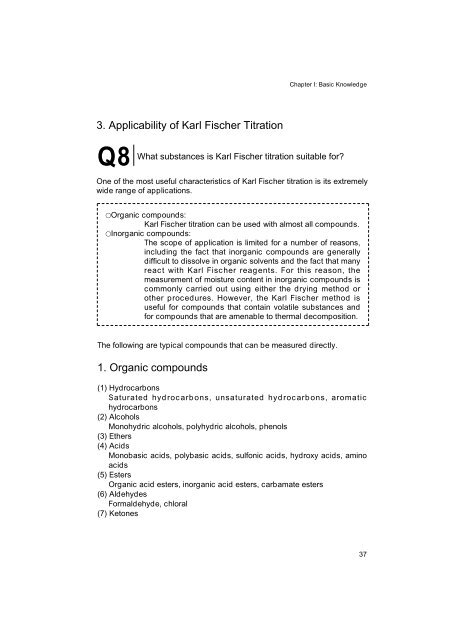Development of Karl Fischer Reagents
Development of Karl Fischer Reagents
Development of Karl Fischer Reagents
Create successful ePaper yourself
Turn your PDF publications into a flip-book with our unique Google optimized e-Paper software.
3. Applicability <strong>of</strong> <strong>Karl</strong> <strong>Fischer</strong> Titration<br />
Q8<br />
Chapter I: Basic Knowledge<br />
What substances is <strong>Karl</strong> <strong>Fischer</strong> titration suitable for?<br />
One <strong>of</strong> the most useful characteristics <strong>of</strong> <strong>Karl</strong> <strong>Fischer</strong> titration is its extremely<br />
wide range <strong>of</strong> applications.<br />
�Organic compounds:<br />
<strong>Karl</strong> <strong>Fischer</strong> titration can be used with almost all compounds.<br />
�Inorganic compounds:<br />
The scope <strong>of</strong> application is limited for a number <strong>of</strong> reasons,<br />
including the fact that inorganic compounds are generally<br />
difficult to dissolve in organic solvents and the fact that many<br />
react with <strong>Karl</strong> <strong>Fischer</strong> reagents. For this reason, the<br />
measurement <strong>of</strong> moisture content in inorganic compounds is<br />
commonly carried out using either the drying method or<br />
other procedures. However, the <strong>Karl</strong> <strong>Fischer</strong> method is<br />
useful for compounds that contain volatile substances and<br />
for compounds that are amenable to thermal decomposition.<br />
The following are typical compounds that can be measured directly.<br />
1. Organic compounds<br />
(1) Hydrocarbons<br />
Saturated hydrocarbons, unsaturated hydrocarbons, aromatic<br />
hydrocarbons<br />
(2) Alcohols<br />
Monohydric alcohols, polyhydric alcohols, phenols<br />
(3) Ethers<br />
(4) Acids<br />
Monobasic acids, polybasic acids, sulfonic acids, hydroxy acids, amino<br />
acids<br />
(5) Esters<br />
Organic acid esters, inorganic acid esters, carbamate esters<br />
(6) Aldehydes<br />
Formaldehyde, chloral<br />
(7) Ketones<br />
37




